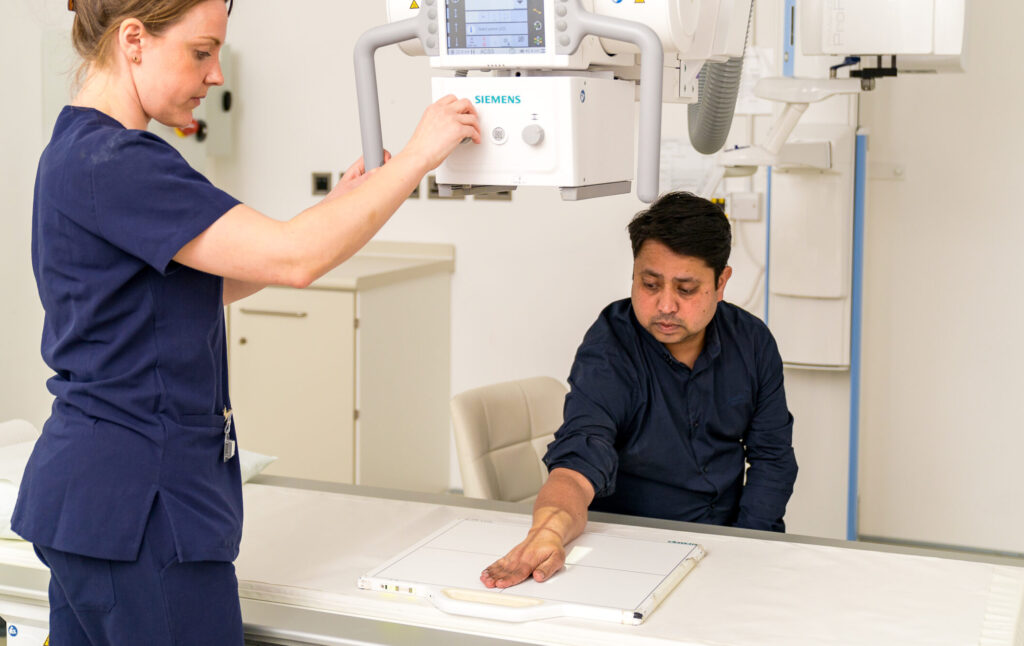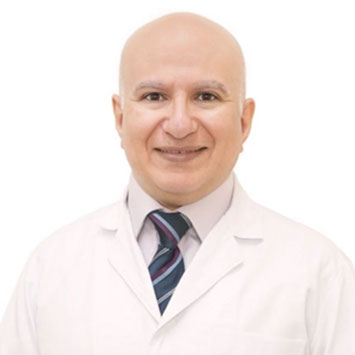What is trigger finger?
Trigger finger is a condition that affects one or more of the hand’s flexor tendons, which are responsible for bending the fingers and thumb. These tendons traverse narrow tunnels in the palm and fingers. If a tendon, or the tunnel a tendon runs through, becomes swollen and inflamed, the tendon can “catch” and not glide smoothly. If the tendon gets caught in the sheath, the finger clicks painfully as it straightens. Trigger finger release surgery is a minor operation that involves making a slit in the tendon sheath to allow the fingers to move freely again.
Symptoms of trigger finger
Following consultant assessment and advice, Trigger Finger Release surgery is often advised when experiencing any or all of the following symptoms or if other treatments such as steroid injections, anti-inflammatories and a splint have proven unsuccessful:
- A painful catching or popping feeling when you bend and straighten your finger, particularly first thing in the morning. This can affect more than one finger, including the ring finger.
- Your finger gets stuck in a bent position
- A sore lump (nodule) in your palm at the base of the affected finger
- Stiffness in your finger or thumb
- Pain in the palm of your hand
- Discomfort or pain when gripping objects
Causes of trigger finger
The precise cause of trigger finger is not fully understood. However, it is more frequently observed in individuals with diabetes or rheumatoid arthritis. It is most prevalent among people in their 40s and 50s, with a higher occurrence in women.
When the thumb is affected, the condition is called trigger thumb, and it can be influenced by repetitive movements or strain.
Treatment for trigger finger
The approach to treating trigger finger varies depending on the severity and duration of your symptoms. Several treatment options are available, including:
- Resting your hand and avoiding strenuous gripping activities
- Taking anti-inflammatory medications, such as aspirin or ibuprofen, to help reduce pain
- Using a splint, particularly at night, to keep your finger straight and prevent morning locking
If your symptoms persist, a corticosteroid injection at the base of the finger or thumb is often recommended. This treatment resolves symptoms completely in approximately 70% of cases and can be administered during a consultation with one of our Hand & Wrist specialists, taking only a few minutes. You can resume your regular activities immediately afterward.
Surgery might be suggested if other treatments are ineffective or unsuitable. Trigger finger surgery is highly effective, and it is uncommon for the issue to recur in the treated finger or thumb.
Hospital fee guide price: £1,320*
More about pricingBefore surgery
Initially, you’ll come in for a consultation with one of our hand & wrist surgeons. During the first consultation for trigger finger release, the doctor will review your medical history, discuss your symptoms, and examine your hand to check for tenderness, swelling, or difficulty straightening the affected finger. They may ask you to open and close your fist to observe tendon movement and confirm the diagnosis, which is usually based on the physical exam. Treatment options will be discussed, including non-surgical methods like splinting, rest, or corticosteroid injections, as well as surgical release for severe or persistent cases. If surgery is chosen, the doctor will explain the procedure, its risks, and the next steps for preparation and aftercare.
Pre-admission process
You may be asked to attend a pre-admission consultation before your surgery, to best prepare you for the operation.
During this consultation, your doctor will review any medications (including over-the-counter drugs and supplements) you are currently taking. You may be advised to stop taking certain medications, such as aspirin or ibuprofen, blood thinning medication or supplements in the weeks leading up to your surgery. Additionally, you’ll need to stop smoking, as it increases the risk of complications, like infection.
Your doctor may also perform tests, such as blood tests, X-Rays, ultrasound, or an electrocardiogram (ECG), to evaluate your overall fitness for the surgery. If you have specific health concerns, further tests might be required.
At this appointment, you will receive important information, including:
- Instructions on what to eat and drink before your procedure (e.g., fasting for six hours, depending on the type of anaesthetic used)
- An estimated timeline for your full recovery
- Guidance on any medications you should start or stop before surgery
- What to expect after your trigger finger surgery
Your consultant will also discuss the potential risks of the surgery and answer any questions you may have. Finally, you will be asked to sign a consent form to confirm your agreement to proceed with the trigger finger release surgery.
During surgery
Trigger finger release is a minimally invasive surgery carried out as a minor op procedure, under local anaesthetic, in our outpatient department.
The local anaesthetic will numb the area of the palm where the surgeon will make a small cut to gain access to the tendon. The surgeon will then open the fibrous tunnel that is causing the trigger finger which will release the tight sheath and allow the tendon in your hand to move freely again. The incision will then be stitched up and the hand bandaged. A long-acting local anaesthetic may be injected around the operation site to keep the palm area pain-free afterwards. This may cause the palm and fingers to feel numb for up to 10 hours.
The procedure will take approximately 15-30 minutes, depending on whether more than one finger is involved.
After surgery
After the surgery, you will be discharged on the same day. You should be able to move your finger immediately following the procedure. Under your doctor’s guidance, the bandages can be removed after a few days. Full movement of the finger should be regained within a few weeks. However, if multiple fingers were operated on, the recovery period might be extended.
Immediate post-surgery care
Our hand and wrist experts can connect you with our specialised hand therapy team. They will offer exercises and advice to support a smooth and successful recovery process.
If your job involves desk work or manual labour, such as driving or frequent hand use, exercise caution when using the affected fingers during the first two weeks. Light daily activities and work are generally acceptable but refrain from heavy lifting for two weeks following the surgery.
Avoid driving for at least the initial seven to ten days post-surgery. Consult your doctor about when it is safe to resume driving, and only do so when you feel confident in your ability.
For those who participate in sports, it may be necessary to avoid intense exercises for the first ten days or so and refrain from heavy lifting for a longer period. Follow your doctor’s advice.
Appointment and Treatment Plan
Appointment
Based on your previous consultation with a doctor, an appointment will be arranged between you and your surgeon.
Treatment plan
During your initial consultation you will discuss the treatment plan and agree on next steps with your surgeon.
Pre-op assessment
If surgery is an option, then the surgeon and their team will thoroughly assess whether you’re right for the surgery. They’ll consider your current health, any previous issues, and other external matters.
Surgery
Prior to going through the surgery, our team will ensure that you’re prepped once again. If everything is confirmed, you’ll undergo the surgery and then we’ll explain the aftercare instructions.
Aftercare
If necessary, you’ll stay in a ward for a few hours to ensure that you’re ready to go home after the surgery. However, this may depend on the surgery outcome and whether you need moderate or light assistance.
Follow-Up
You’ll come in a few weeks later and we’ll give you one final check-over to ensure that you’re on track for recovery.
Experts
We are proud to provide patients with access to a wide range of clinicians, chosen specifically for their knowledge and reputation in their area of expertise. Our experts align with our values: putting you at the centre of your care and educating you on your options at each step of the journey. We encourage you to learn more about our clinicians and how they can help you below. As always, please contact our patient services team if you require any additional information.
We offer 3 ways to pay for your treatment
We exist to take the stress out of private healthcare.
Our payment options are designed to offer you easy access to our treatments and services. You can choose to pay on the day, spread the cost, or use your private medical insurance.
Our patient services team will guide you through the process, providing clear costs and support throughout your course of treatment so you can focus on the thing that matters most – your health.
Whether you pay in advance, spread the cost, or use your private medical insurance, rest assured you will be receiving exceptional care 365 days a year.
Pay in Advance
Even if you do not have medical insurance, you can still get quick and comprehensive access to private medical care.
We provide transparent pricing from your initial consultation to the completion of your treatment so you know where your stand, every step of the way.
We accept all major debit and credit cards, as well as Apple Pay for UK residents. Please note that we do not accept cash or cheques.
Pay monthly
Paying for your treatment at OSD Healthcare doesn’t need to mean settling the full cost in one go.
Many of our treatments have a pay monthly option that allows you to spread the cost of your treatment over 12 months with no credit checks required.
A minimum spend of £300 does apply. We’ll take your first payment upfront and then arrange a direct debit for your monthly payments thereafter. It’s that simple.
Pay using PMI
We are recognised by all major health insurance companies and with our extensive range of services, there are lots of benefits to using your insurance with us. Our patient services team is here to answer any questions you may have about using your private health insurance with us.
Please bring along your policy details including your scheme details, membership or policy number, expiry date and confirmation of eligibility to claim (i.e. your authorisation number). If you do not have these details with you, we will require payment from you on the day. Patients are liable for any amounts not settled by their insurer.
Pricing
Hospital fee guide price: £1,320
Procedure price subject to bespoke quotation.
Additional consultant fee not included.
FAQs
The recovery time for trigger finger release surgery varies depending on the individual and the severity of the condition. Generally, it can take several weeks to several months to fully recover from the surgery.
Immediately after surgery, you may experience pain, swelling, and bruising in the affected hand or finger. Your doctor may prescribe pain medication to help manage these symptoms. It’s important to rest your hand and finger for several days after surgery and avoid heavy lifting, bending, or gripping.
You may need to wear a splint or bandage to protect the affected finger or thumb. Physical therapy may also be necessary to help restore strength and mobility to the affected hand or finger. Your doctor will provide you with a rehabilitation plan to help you recover from the surgery.
Following your doctor’s instructions carefully is crucial to ensure a smooth and successful recovery. With proper care and rehabilitation, you should be able to return to your normal activities within a few weeks to a few months.
As with any surgical procedure, trigger finger release surgery carries certain risks and potential complications. It’s important to be aware of these before deciding to proceed with the surgery.
- Infection: There is a risk of infection at the surgical site, which can usually be managed with antibiotics.
- Nerve Damage: The nerves in the hand and fingers can be damaged during surgery, potentially leading to numbness, tingling, or pain.
- Scarring: The surgery can result in scarring, which may be permanent. While this is usually minimal, it can be a cosmetic concern for some patients.
- Complex Regional Pain Syndrome: This is a rare but serious complication that can cause chronic pain, swelling, and limited mobility in the affected hand or finger.
- Recurrence: Although trigger finger release surgery is generally effective, there is a possibility that the condition can recur, especially if the underlying cause is not addressed.
Understanding these risks can help you make an informed decision about whether to proceed with trigger finger release surgery.
Trigger thumb, also known as stenosing tenosynovitis of the thumb, is a specific type of trigger finger that affects the thumb. The symptoms of trigger thumb are similar to those of trigger finger, including pain, stiffness, and a clicking or snapping sensation when bending or straightening the thumb.
Trigger thumb often results from repetitive strain or overuse of the thumb, such as from gripping or grasping objects. It can also be associated with underlying medical conditions like rheumatoid arthritis or diabetes.
If you’re not ready for trigger finger surgery, there are several alternative treatments you can explore. These non-surgical options can help manage the symptoms and improve the function of the affected finger or thumb.
Splinting: Wearing a splint on the affected finger or thumb can help reduce movement and ease pain. This is particularly useful at night to keep the finger straight and prevent it from locking.
Physical Therapy: A physical therapist can teach you exercises to stretch and strengthen your fingers and thumb. These exercises can improve flexibility and reduce stiffness.
Medications: Over-the-counter pain relievers such as ibuprofen can help reduce pain and inflammation. These medications can be particularly effective when combined with other treatments.
Corticosteroid Injections: Injecting corticosteroids into the affected tendon sheath can help reduce inflammation and relieve pain. This treatment is often effective and can provide relief for several months.
Rest and Ice: Resting the affected finger or thumb and applying ice can reduce swelling and inflammation. This simple approach can be very effective, especially in the early stages of developing trigger finger.
These alternatives can be effective in managing trigger finger symptoms, but if they do not provide sufficient relief, trigger finger release surgery may be the next step.
Medically reviewed by Mr Nawfal Al-Hadithy - Consultant Trauma & Orthopaedic Shoulder, Elbow & Hand Surgeon on 23/12/2024





